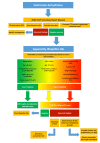Role of Cardiac Magnetic Resonance Imaging in Patients with Idiopathic Ventricular Arrhythmias
- PMID: 30251607
- PMCID: PMC6367696
- DOI: 10.2174/1573403X14666180925095923
Role of Cardiac Magnetic Resonance Imaging in Patients with Idiopathic Ventricular Arrhythmias
Abstract
Ventricular Arrhythmias (VAs) may present with a wide spectrum of clinical manifestations ranging from mildly symptomatic frequent premature ventricular contractions to lifethreatening events such as sustained ventricular tachycardia, ventricular fibrillation and sudden cardiac death. Myocardial scar plays a central role in the genesis and maintenance of re-entrant arrhythmias which are commonly associated with Structural Heart Diseases (SHD) such as ischemic heart disease, healed myocarditis and non-ischemic cardiomyopathies. However, the arrhythmogenic substrate may remain unclear in up to 50% of the cases after a routine diagnostic workup, comprehensive of 12-lead surface ECG, transthoracic echocardiography and coronary angiography/ computed tomography. Whenever any abnormality cannot be identified, VAs are referred as to "idiopathic". In the last decade, Cardiac Magnetic Resonance (CMR) imaging has acquired a growing role in the identification and characterization of myocardial arrhythmogenic substrate, not only being able to accurately and reproducibly quantify biventricular function, but, more importantly, providing information about the presence of myocardial structural abnormalities such as myocardial fatty replacement, myocardial oedema, and necrosis/ fibrosis, which may otherwise remain unrecognized. Moreover, CMR has recently demonstrated to be of great value in guiding interventional treatments, such as radiofrequency ablation, by reliably identifying VA sites of origin and improving long-term outcomes. In the present manuscript, we review the available data regarding the utility of CMR in the workup of apparently "idiopathic" VAs with a special focus on its prognostic relevance and its application in planning and guiding interventional treatments.
Keywords: Cardiac magnetic resonance; idiopathic; late gadolinium enhancement; structural heart disease; tissue characterization; ventricular arrhythmias..
Copyright© Bentham Science Publishers; For any queries, please email at epub@benthamscience.org.
Figures








Similar articles
-
Prevalence and prognostic value of concealed structural abnormalities in patients with apparently idiopathic ventricular arrhythmias of left versus right ventricular origin: a magnetic resonance imaging study.Circ Arrhythm Electrophysiol. 2014 Jun;7(3):456-62. doi: 10.1161/CIRCEP.113.001172. Epub 2014 Apr 25. Circ Arrhythm Electrophysiol. 2014. PMID: 24771543
-
Cardiac magnetic resonance for ventricular arrhythmias: a systematic review and meta-analysis.Heart. 2024 Aug 26;110(18):1113-1123. doi: 10.1136/heartjnl-2024-324182. Heart. 2024. PMID: 39084706
-
CMR for Identifying the Substrate of Ventricular Arrhythmia in Patients With Normal Echocardiography.JACC Cardiovasc Imaging. 2020 Feb;13(2 Pt 1):410-421. doi: 10.1016/j.jcmg.2019.04.023. Epub 2019 Jul 17. JACC Cardiovasc Imaging. 2020. PMID: 31326488
-
Predictors of Left Ventricular Scar Using Cardiac Magnetic Resonance in Athletes With Apparently Idiopathic Ventricular Arrhythmias.J Am Heart Assoc. 2021 Jan 5;10(1):e018206. doi: 10.1161/JAHA.120.018206. Epub 2020 Dec 31. J Am Heart Assoc. 2021. PMID: 33381977 Free PMC article.
-
The scar: the wind in the perfect storm-insights into the mysterious living tissue originating ventricular arrhythmias.J Interv Card Electrophysiol. 2023 Jan;66(1):27-38. doi: 10.1007/s10840-021-01104-w. Epub 2022 Jan 24. J Interv Card Electrophysiol. 2023. PMID: 35072829 Free PMC article. Review.
Cited by
-
Cardiovascular magnetic resonance clarifies arrhythmogenicity in asymptomatic young athletes with ventricular arrhythmias undergoing pre-participation evaluation.Exp Ther Med. 2020 Jul;20(1):561-571. doi: 10.3892/etm.2020.8693. Epub 2020 Apr 29. Exp Ther Med. 2020. PMID: 32537014 Free PMC article.
-
Frequent Ventricular Premature Beats in Children and Adolescents: Natural History and Relationship with Sport Activity in a Long-Term Follow-Up.Pediatr Cardiol. 2020 Jan;41(1):123-128. doi: 10.1007/s00246-019-02233-w. Epub 2019 Nov 11. Pediatr Cardiol. 2020. PMID: 31712859
-
Therapies to limit myocardial injury in animal models of myocarditis: a systematic review and meta-analysis.Basic Res Cardiol. 2019 Oct 31;114(6):48. doi: 10.1007/s00395-019-0754-x. Basic Res Cardiol. 2019. PMID: 31673885 Free PMC article.
-
Imaging Modality Selection in Cardiac Ablation.J Innov Card Rhythm Manag. 2022 Apr 15;13(4):4968-4980. doi: 10.19102/icrm.2022.130402. eCollection 2022 Apr. J Innov Card Rhythm Manag. 2022. PMID: 35521069 Free PMC article.
-
Cardiolipotoxicity, Inflammation, and Arrhythmias: Role for Interleukin-6 Molecular Mechanisms.Front Physiol. 2019 Jan 7;9:1866. doi: 10.3389/fphys.2018.01866. eCollection 2018. Front Physiol. 2019. PMID: 30666212 Free PMC article. Review.
References
-
- Tan A.Y., Ellenbogen K. Ventricular arrhythmias in apparently normal hearts. Card. Electrophysiol. Clin. 2016;8:613–621. - PubMed
-
- Nucifora G., Muser D., Masci P.G., et al. Prevalence and prognostic value of concealed structural abnormalities in patients with apparently idiopathic ventricular arrhythmias of left versus right ventricular origin A magnetic resonance imaging study. Circ Arrhythm Electrophysiol. 2014;7:456–462. - PubMed
-
- Mahida S., Sacher F., Dubois R., et al. Cardiac imaging in patients with ventricular tachycardia. Circulation. 2017;136:2491–2507. - PubMed
-
- Latif S., Dixit S., Callans D.J. Ventricular arrhythmias in normal hearts. Cardiol. Clin. 2008;26:367–380. - PubMed
-
- Saksena S., Camm A.J. Electrophysiological disorders of the heart: Expert consult. Elsevier Health Sciences; 2011.
Publication types
MeSH terms
LinkOut - more resources
Full Text Sources
Other Literature Sources
Medical

